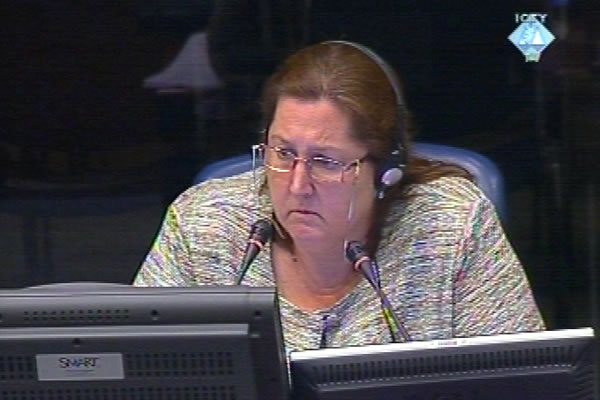Home
KARADZIC: EVERYTHING WAS IN LINE WITH THE LAW
Karadzic argued that the Serb crisis staffs were established in line with the Law on All People’s Defense of the former SFRY and SRBH and not the Instruction of the SDS Executive Board issued in December 1991, which envisaged the takeover of power in municipalities with a Serb majority, as the prosecution expert Dorothea Hanson claimed. According to the accused, everything was done ‘in line with the law’
 Dorothea Hanson, witness at the Radovan Karadzic trial
Dorothea Hanson, witness at the Radovan Karadzic trial Former Republika Srpska president Radovan Karadzic denies the findings of prosecution expert Dorothea Hanson that the Serb crisis staffs implemented a policy to resettle non-Serbs out of the municipalities where Serbs were in power. Continuing the cross-examination of the prosecution expert, Karadzic argued that the Serb authorities did ‘everything in line with the law’ and that the resettlement of the non-Serbs was a consequence of the ‘winds of war’: the crisis staffs were not responsible for it.
According to Karadzic, the document which served as a basis for the establishment of the crisis staffs was the Law on All People’s Defense of the former SFRY and SRBH. As Karadzic said, the Instruction of the SDS Executive Board issued in December 1991 with Variants A and B for the takeover of power in the municipalities had nothing to do with the crisis staffs, contrary to what the witness wrote in her expert report. Karadzic spent a good part of his cross-examination quoting from the federal and republican law, insisting on the ‘right and obligation’ of the people to organize themselves in the event of war or major disasters.
Karadzic complained that the witness was not impartial because in her report she attributed the ‘invention’ of crisis staffs ‘exclusively to the SDS’. Karadzic noted that the SDA and the HDZ formed their own crisis staffs several months before the Serbs did. In fact, as he said, on 21 September 1991 the BH Presidency established the crisis staff at the level of the republic.
Hanson replied that she never claimed the SDS ‘invented’ the crisis staffs, that other parties didn’t establish them and that crisis staffs were ‘illegal and unlawful’ as such. This did not in any way influence her conclusions about the Bosnian Serb crisis staffs, established on the orders of the SDS, she added. The witness didn’t agree with Karadzic that the Serb crisis staffs were not established before April 1992: according to her, this was the time when the crisis staffs were ‘legalized’.
Karadzic put it to the witness that the relocation of Muslims from Bosanski Petrovac in the summer of 1992 was the ‘best solution’ at the time as the Serb authorities couldn’t guarantee their safety. Karadzic also said that the Serb forces had to fight the ‘rebels’ ‘deep inside of the Serb territory’; 1,278 citizens of Kljuc were not detained on the grounds of their ‘religion and ethnicity’, but because they had taken part in ‘armed rebellion’.
According to the witness, however, the Serb authorities could have made an additional effort to ensure the safety of the non-Serbs instead of relocating them. Hanson rejected the claim of the accused that the men detained in Kljuc had been ‘rebels’. Hanson insisted that no Serbs were ever arrested for illegal possession of weapons or fomenting ethnic intolerance, two main grounds for the arrest of Muslims according to the documents produced by the Serb authorities.
The trial continues on Friday, 17 June 2011.
Linked Reports
- Case : Karadzic
- 2011-06-09 CRISIS STAFFS RELOCATED PEOPLE AS PART OF POLICY
- 2011-06-08 KARADZIC’S VERSION OF HISTORY AND REALITY
- 2011-06-07 WITNESS: BATKO WAS ‘AN ARMED MONSTER’
- 2011-06-17 DENYING THE ‘POLICY OF RESETTLEMENT’ OF MUSLIMS AND CROATS
- 2011-06-20 DID COMMUNICATIONS IN REPUBLIKA SRPSKA FUNCTION?
- 2011-06-21 KARADZIC’S COMMUNICATIONS DURING THE WAR
